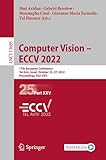Computer Vision - ECCV 2022 [electronic resource] : 17th European Conference, Tel Aviv, Israel, October 23-27, 2022, Proceedings, Part XXV / edited by Shai Avidan, Gabriel Brostow, Moustapha Cissé, Giovanni Maria Farinella, Tal Hassner.
Contributor(s): Avidan, Shai [editor.] | Brostow, Gabriel [editor.]
| Brostow, Gabriel [editor.] | Cissé, Moustapha [editor.]
| Cissé, Moustapha [editor.] | Farinella, Giovanni Maria [editor.]
| Farinella, Giovanni Maria [editor.] | Hassner, Tal [editor.]
| Hassner, Tal [editor.] | SpringerLink (Online service)
| SpringerLink (Online service) .
.
Material type:  BookSeries: Lecture Notes in Computer Science: 13685Publisher: Cham : Springer Nature Switzerland : Imprint: Springer, 2022Edition: 1st ed. 2022.Description: LVI, 759 p. 224 illus., 216 illus. in color. online resource.Content type: text Media type: computer Carrier type: online resourceISBN: 9783031198069.Subject(s): Computer vision
BookSeries: Lecture Notes in Computer Science: 13685Publisher: Cham : Springer Nature Switzerland : Imprint: Springer, 2022Edition: 1st ed. 2022.Description: LVI, 759 p. 224 illus., 216 illus. in color. online resource.Content type: text Media type: computer Carrier type: online resourceISBN: 9783031198069.Subject(s): Computer visionCross-Domain Ensemble Distillation for Domain Generalization -- Centrality and Consistency: Two-Stage Clean Samples Identification for Learning with Instance-Dependent Noisy Labels -- Hyperspherical Learning in Multi-Label Classification -- When Active Learning Meets Implicit Semantic Data Augmentation -- VL-LTR: Learning Class-Wise Visual-Linguistic Representation for Long-Tailed Visual Recognition -- Class Is Invariant to Context and Vice Versa: On Learning Invariance for Out-of-Distribution Generalization -- Hierarchical Semi-Supervised Contrastive Learning for ContaminationResistant Anomaly Detection -- Tracking by Associating Clips -- RealPatch: A Statistical Matching Framework for Model Patching with Real Samples -- Background-Insensitive Scene Text Recognition with Text Semantic Segmentation -- Semantic Novelty Detection via Relational Reasoning -- Improving Closed and Open-Vocabulary Attribute Prediction Using Transformers -- TrainingVision Transformers with Only 2040 Images -- Bridging Images and Videos: A Simple Learning Framework for Large Vocabulary Video Object Detection -- TDAM: Top-Down Attention Module for Contextually Guided Feature Selection in CNNs -- Automatic Check-Out via Prototype-Based Classifier Learning from Single-Product Exemplars -- Overcoming Shortcut Learning in a Target Domain by Generalizing Basic Visual Factors from a Source Domain -- Photo-Realistic Neural Domain Randomization -- Wave-ViT: Unifying Wavelet and Transformers for Visual Representation Learning -- Tailoring Self-Supervision for Supervised Learning -- Difficulty-Aware Simulator for Open Set Recognition -- Few-Shot Class-Incremental Learning from an Open-Set Perspective -- FOSTER: Feature Boosting and Compression for Class-Incremental Learning -- Visual Knowledge Tracing -- S3C: Self-Supervised Stochastic Classifiers for Few-Shot ClassIncremental Learning -- Improving Fine-Grained Visual Recognition in Low Data Regimes via Self-Boosting Attention Mechanism -- VSA: Learning Varied-Size Window Attention in Vision Transformers -- Unbiased Manifold Augmentation for Coarse Class Subdivision -- DenseHybrid: Hybrid Anomaly Detection for Dense Open-Set Recognition -- Rethinking Confidence Calibration for Failure Prediction -- Uncertainty-Guided Source-Free Domain Adaptation -- Should All Proposals Be Treated Equally in Object Detection? -- VIP: Unified Certified Detection and Recovery for Patch Attack with Vision Transformers -- incDFM: Incremental Deep Feature Modeling for Continual Novelty Detection -- IGFormer: Interaction Graph Transformer for Skeleton-Based Human Interaction Recognition -- PRIME: A Few Primitives Can Boost Robustness to Common Corruptions -- Rotation Regularization without Rotation -- Towards Accurate Open-Set Recognition via Background-Class Regularization -- In Defense of Image Pre-trainingfor Spatiotemporal Recognition -- Augmenting Deep Classifiers with Polynomial Neural Networks -- Learning with Noisy Labels by Efficient Transition Matrix Estimation to Combat Label Miscorrection -- Online Task-Free Continual Learning with Dynamic Sparse Distributed Memory.
The 39-volume set, comprising the LNCS books 13661 until 13699, constitutes the refereed proceedings of the 17th European Conference on Computer Vision, ECCV 2022, held in Tel Aviv, Israel, during October 23-27, 2022. The 1645 papers presented in these proceedings were carefully reviewed and selected from a total of 5804 submissions. The papers deal with topics such as computer vision; machine learning; deep neural networks; reinforcement learning; object recognition; image classification; image processing; object detection; semantic segmentation; human pose estimation; 3d reconstruction; stereo vision; computational photography; neural networks; image coding; image reconstruction; object recognition; motion estimation.


There are no comments for this item.